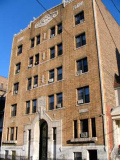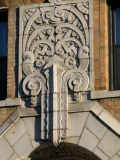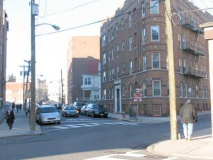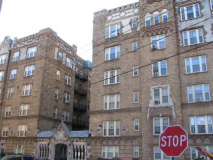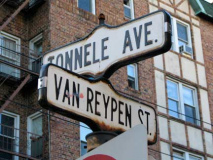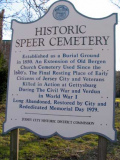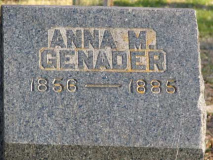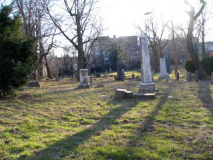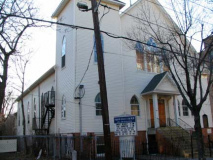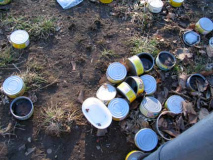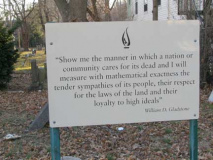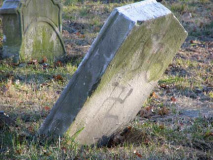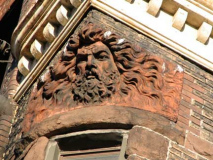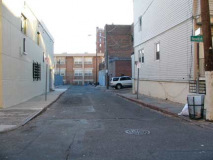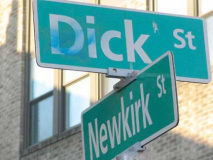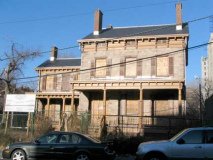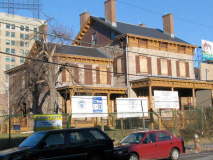In the years following the Dutch settlement of New Amsterdam on the southern end of Manhattan Island in the mid-1620s, the settlers had interest in the lands surrounding it in Long Island, Staten Island and present-day New Jersey. By the 1650s, by then under the rule of Director General Peter Stuyvesant, the Netherlands had acquired from the indigenous Native Americans, by purchase and by warfare, a lot of territory comprising today’s Jersey City, Newark, Bayonne, and other cities just across the North (Hudson) River from Manhattan. After a violent incident…
[T]he governor of New Netherland, Peter Stuyvesant, issued an ordinance declaring that all settlers must “concentrate themselves by the next spring in the form of towns, villages, and hamlets, so that they might be more effectively protected, maintained and defended against all assaults and attacks by the barbarians.”
 Two years later, Stuyvesant engineered the purchase of most of present-day Hudson County. For this real estate, the Indians received: 80 fathoms of wampum, 20 fathoms of cloth, 12 brass kettles, 1 double brass kettle, 6 guns, 2 blankets and a barrel of strong beer. Jersey City Landmarks
Two years later, Stuyvesant engineered the purchase of most of present-day Hudson County. For this real estate, the Indians received: 80 fathoms of wampum, 20 fathoms of cloth, 12 brass kettles, 1 double brass kettle, 6 guns, 2 blankets and a barrel of strong beer. Jersey City Landmarks
In November 1660 a new settlement called Bergen, after a city in northern Holland, was organized.
The town was directed to be laid out by Jacques Cortelyou, the first surveyor of New Amsterdam. It was in the form of a square, eight hundred feet long on each side, with two cross streets meeting at right angles in the center, where a vacant space was reserved, one hundred and sixty feet by two hundred and twenty-five feet. These streets divided the plot into four quarters, which were subdivided into building lots. Along the outer side of the plot palisades were erected, with gates at the termination of the cross streets, which were closed at night, or when any attack of Indians was threatened. The original plan is still preserved at Bergen Square, Academy Street and Bergen Avenue being the intersecting cross streets, while Tuers and Idaho Avenues on the east and west, and Newkirk and Vroom Streets on the north and south, mark the line of the palisades.
The plan survives today in the middle of modern Jersey City, just south of Journal Square. The street at the north end is now Newkirk Street; in the center, Academy; on the south, Vroom; and on the west, Van Reypen; in the center, Bergen Avenue; and on the east, Tuers Avenue. Even the wide square in the center where Bergen meets Academy is still there, as buildings are set back in the street on all sides. Gravesend, in southern Brooklyn, is similarly laid out, but Gravesend was originally settled by a Britisher seeking religious freedom, Deborah Moody.
GOOGLE MAP: BERGEN SQUARE, JERSEY CITY
Getting there from NYC: PATH from World Trade Center or 33rd Street to Journal Square; walk south along Journal Square, then Bergen Avenue. The heart of Bergen Square is at Academy Street.
At the western end of the square, at Academy and Van Reypen Streets, we find a cluster of handsome apartment buildings and a classic enamel-embossed street sign marking the humble southern end of one of Jersey City-Hudson County’s busiest routes, Tonnele Avenue, which, traveling north, picks up steam, passing busy Tonnele Circle and the Pulaski Skyway to Newark as part of pedal to the metal US Routes 1-9 and entering Bergen County. The road is named for the Tonnele family, early Jersey City settlers, and is occasionally spelled with two Ls.
A brief walk south on Van Reypen reveals some more engaging architetcure, including this Art Deco apartment building.
Midway on Vroom (the name seems more appropriate to Tonnele Avenue) between Van Reypen Street and Bergen Avenue is the Vroom Street Church and the adjacent Speer Cemetery, which is connected to the Dutch Reformed Church around the corner on Bergen and Highland Avenues.
The oldest cemetery in Jersey City, the Old Bergen Church Cemetery served as the final resting place for the Dutch members of the Old Bergen Church founded in 1660. Its first recorded burial took place in 1668. The original grave markers were carved of wood and did not survive years of exposure to the elements.
The oldest remaining stone markers date from the late 1700s and bear the names of the descendants of the founding Dutch families. Among them are Brinkerhoff, Newkirk, Sip, Van Houten, Van Reypen, Van Vorst, Van Wagenen, and Van Winkle. Among the approximate 150 graves are those of the legendary Revolutionary War patriot Jane Van Reypen Tuers and two pastors of the Dutch Reformed Church, the Reverend William Jackson (1757-1793 and the Reverend John Cornelison (1793-1828). When Bergen Avenue was widened in 1926, some of the graves were moved to the Arlington Cemetery in North Arlington, New Jersey.
Jersey City Past and Present
If they’re serious about that quote, I’d suggest whoever is in charge of caring for the cemetery –whether it be the Reformed Church or the Vroom Street Church… scrub the swastika off that gravestone and clean up the Li’l Friskies cans someone is leaving for the cats. Sheesh.
Nine-story apartment at Bergen Avenue and Academy. This was once the site of the historicSip Manor, visited, or some say commandeered by British general Lord Cornwallis during the Revolutionary War. It was disassembled in 1924 and reassembled on Cherry Lane in Westfield, Union County, NJ in 1929.
The Purloined Manor [NJ History’s Mysteries]
“Pegleg Pete” presides over the entrance of Martin Luther King High School on Bergen north of Academy. The statue dates to 1913 and was sculpted by J. Massey Rhind.
Alley fans have a lot to see in J.C., including Dick Street, a dead-end off Newkirk just east of Bergen Avenue.
The Apple Tree House, a.k.a. the Van Wegenen Homestead, 298 Academy Street near Van Reypen, is one of the oldest buildings in Jersey City, dating officially to 1740 though it may go back to the early years of Bergen Square in the 1660s.
The Garretsen (later Van Wegenen) family owned the property and the building itself from 1658-1947, a span of some 289 years. Thereafter the Quinn family ran it as a funeral parlor for 40 years. The building began to gradually deteriorate as far back as the 1950s; it was purchased by the Hudson County Board of Freeholders in 1994, leasing to to Jersey City. Various plans have been on the books to restore and reopen it as a museum or education center.
According to legend (it has been largely disproven) George Washington and the Marquis de Lafayette met here to discuss strategy here on August 24, 1779, as Lafayette made his headquarters here. It was the tallest building in the area and offered a strategic vantage point. There was an apple orchard in the back of the building, where Newkirk Street runs today.
A felled tree from the apple orchard was supposedly used to fashion a cane presented to Lafayette during his triumphant visit to the USA in 1824. Once again, though, it’s a nice story, but has been largely shown to be just a story.
The Apple Tree House has been stabilized and is no longer in danger of collapse, but reopening it soon is another story. Hopefully the funds can be found…somewhere.
2/22/08


